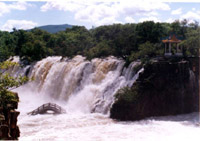 Mudanjiang is a major tourist city in northeast China in the south of Heilongjiang province, and is known for its beautiful mountains, lakes and luxuriant forests.
Mudanjiang is a major tourist city in northeast China in the south of Heilongjiang province, and is known for its beautiful mountains, lakes and luxuriant forests.
Mudanjiang is one of the best-known tourist cities in northeast China.
Neighboring the city of Harbin in the north and bordering Russia in the east, it attracts millions of visitors from home and abroad each year with its enchanting vistas of mountains and waters.
Jingbohu, or Mirror Lake, usually tops the lists of most tourists? itineraries. Surrounded by beautiful mountains in the south of the city, it is one of the most famous scenic spots in the country and often referred to as north China?s West Lake.
Jingbohu covers an area of 90 square kilometers and has an average depth of 40 meters. It?s shaped in the letter "S", and zigzags from the south to the north, with islets dotted here and there.
As its name indicates, the sprawling water surface is as placid and limpid as a huge mirror. The lake is so clear that you can actually see the fish swimming happily among the water plants.
Jingpohu is the second largest volcanic barrier lake in the world, second only to Lake Geneva in Switzerland. It was formed some ten thousand years ago when the flowing lava from a volcanic eruption blocked the Mudanjiang River which ran through the city.
There are a number of sightseeing spots scattered around the lake area. The most attractive of them is the Diaoshuilou Waterfall at the lake?s northern outlet. The waterfall is usually 40 meters wide, and in winter it freezes into cliff-hanging icicles, transforming the fall into a glistening tower of crystal. But in summer, the water crashes down the cliff into a deep pool below with a thunderous roar that can be heard for miles around, while the mists turn the sunshine into rainbows, offering a breathtaking spectacle for both eyes and ears.
The lake area has become famous not only for its awesome beauty, but also for its unique volcanic features. The crater underground forests in the mountains northwest of the lake leave many tourists in speechless awe.
The volcanic eruption that took place ten thousand years ago left behind a dozen craters of different sizes and shapes, and in them tourists can find virgin forests of purple pine, fir, dragon spruce and many other rare trees, most of which are hundreds of years old and over 20 meters high. The third crater, 300 meters in diameter and 100 meters deep, is the largest of all. Tourists can go down man-made stone stairs to the lower part of the crater to get a closer look at one of nature?s wonders.
From Jingbohu, visitors can take a bus ride northeast for some 20 kilometers to Bohai town, where the capital of the ancient Bohai Kingdom once stood. The kingdom was built 1200 years ago during the Tang Dynasty by the Mohe people, the ancestors of today?s Manchu ethnic group. Among the city ruins, tourists can pore over many well-preserved historical sites, such as palaces, imperial gardens, temples and mausoleums.
After a trip through history in the ancient capital city, you can go to the Bohai Ethnic Village nearby for a unique experience of the lifestyles and folk customs of the local Manchu and Korean ethnic groups.
In the southeast of Mudanjiang is another famous tourist site, the Mudan Peak Nature Reserve. The place covers an area of 40 thousand hectares, and is blessed with a well preserved primal ecosystem, making it a haven for many species of rare plants.
In the height of summer, the place provides an excellent tourist resort and oxygen bar, while in winter, snow covers the mountain for four months and provides a paradise for snow sport fanatics.
The ski runs here have a variety of tracks catering to the needs of different skiers, and some other exciting ice and snow activities are on offer, such as skating, ice sailing, horse-drawn sleighing and snow motorcycling.
There are many other attractions for tourists to visit in Mudanjiang, such as the Sandaoguan Forest Park, the Xingkai Lake Scenic Area, and the Northeastern Tiger Zoo.
As a major economic centre and tourist city in Heilongjiang province, Mudanjiang is easily accessible both by plane and by train from many big Chinese cities. It also has international air links with cities in the far east of Russia. There are some 30 star-rated hotels in the city, ensuring a comfortable stay for all tourists from home and abroad.
Tansportation: Mudanjiang has its own airport. You can take bus at Mudanjiang to Jingbohu, and it is about 2.5 hours? driving. Two days are enough for sightseeing over there.
(CRI December 12, 2002)
|

